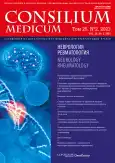Combination of cortical-subcortical infarction with lobar microbleeds as a specific MRI pattern in patients with infective endocarditis
- Authors: Demin D.A.1, Kulesh A.A.2,3, Nikolaeva E.V.4, Shaposhnikova E.I.1, Lezhikova M.V.1, Astanin P.A.5
-
Affiliations:
- Federal Center for Cardiovascular Surgery
- Vagner Perm State Medical University
- City Clinical Hospital №4
- Pyatigorsk City Clinical Hospital №2
- Pirogov Russian National Research Medical University
- Issue: Vol 25, No 2 (2023): Neurology and rheumatology
- Pages: 86-90
- Section: Articles
- URL: https://journals.rcsi.science/2075-1753/article/view/131636
- DOI: https://doi.org/10.26442/20751753.2023.2.202230
- ID: 131636
Cite item
Full Text
Abstract
Background. Ischemic stroke (IS) and cerebral microbleeds (CMB) are the most common types of neurological complications of infective endocarditis (IE), while their combination is poorly understood.
Aim. To evaluate the pattern of combination of cortical-subcortical infarction with lobar CMB or subarachnoid hemorrhage (SAH) in patients with ”left-sided” IE.
Materials and methods. A retrospective case-control study was conducted, including patients with IE who received cardiac surgery at the Federal Center for Cardiovascular Surgery. Inclusion criteria: age of patients ≥18 years; definite or possible (Duke criteria) IE of the left heart (aortic and/or mitral valves). The control group included patients without IE, with non-lacunar (likely embolic) IS. In both groups, the pattern of combination of cortical-subcortical infarction with lobar CMB or SAH was assessed. Differences between groups of patients were assessed using the χ2 test, Fisher's exact test and the Mann–Whitney test. Additionally, odds ratios for binary features were calculated. To assess the information content of the studied pattern, classical classification quality metrics were calculated: accuracy, sensitivity, and specificity.
Results. In patients with IS, infarcts corresponded to the main characteristics of cardioembolism: involvement of multiple cerebral arterial territories (84%), multiple infarcts (88%), cortical-subcortical localization (100%), and a high incidence of hemorrhagic transformation (44%). CMB was detected in 64% of cases (in 93.8%, CMB localization was lobar), SAH – in 28% of patients (with CMB in 6 out of 7 cases). The pattern of combination of cortical-subcortical infarction with lobar CMB or SAH was observed in 64% in the IE group (in the control group – in 12%). Odds ratio for the presence of IE was 13.0 (95% confidence interval 3.04–55.9; p<0.001). The accuracy of the sign was 76%, specificity – 71%, sensitivity – 84%.
Conclusion. The combination of cortical-subcortical infarcts with lobar CMB or SAH may be a sign characteristic of IE-associated stroke.
Keywords
Full Text
##article.viewOnOriginalSite##About the authors
Dmitry A. Demin
Federal Center for Cardiovascular Surgery
Email: demin2404@mail.ru
ORCID iD: 0000-0003-2670-4172
Neurologist
Russian Federation, AstrakhanAleksey A. Kulesh
Vagner Perm State Medical University; City Clinical Hospital №4
Author for correspondence.
Email: aleksey.kulesh@gmail.com
ORCID iD: 0000-0001-6061-8118
D. Sci. (Med.)
Russian Federation, Perm; PermEkaterina V. Nikolaeva
Pyatigorsk City Clinical Hospital №2
Email: novayakatia@mail.ru
ORCID iD: 0000-0001-5701-2449
Radiologist
Russian Federation, PyatigorskElena I. Shaposhnikova
Federal Center for Cardiovascular Surgery
Email: lena.pincetic@gmail.ru
ORCID iD: 0000-0001-9065-1189
Head of the Department of Radiology
Russian Federation, AstrakhanMarina V. Lezhikova
Federal Center for Cardiovascular Surgery
Email: mvlezhikova@mail.ru
ORCID iD: 0009-0005-9534-3843
Neurologist
Russian Federation, AstrakhanPavel A. Astanin
Pirogov Russian National Research Medical University
Email: med_cyber@mail.ru
ORCID iD: 0000-0002-1854-8686
Assistant of Professor
Russian Federation, MoscowReferences
- García-Cabrera E, Fernández-Hidalgo N, Almirante B, et al. Neurological complications of infective endocarditis: risk factors, outcome, and impact of cardiac surgery: a multicenter observational study. Circulation. 2013;127(23):2272-84. doi: 10.1161/CIRCULATIONAHA.112.000813
- Duval X, Iung B, Klein I, et al. Effect of early cerebral magnetic resonance imaging on clinical decisions in infective endocarditis: a prospective study. Ann Intern Med. 2010;152(8):497-504. doi: 10.7326/0003-4819-152-8-201004200-00006
- Ahn Y, Joo L, Suh CH, et al. Impact of Brain MRI on the Diagnosis of Infective Endocarditis and Treatment Decisions: Systematic Review and Meta-Analysis. AJR Am J Roentgenol. 2022;218(6):958-68. doi: 10.2214/AJR.21.26896
- Rizzi M, Ravasio V, Carobbio A, et al. Predicting the occurrence of embolic events: an analysis of 1456 episodes of infective endocarditis from the Italian Study on Endocarditis (SEI). BMC Infect Dis. 2014;14:230. doi: 10.1186/1471-2334-14-230
- Hess A, Klein I, Iung B, et al. Brain MRI findings in neurologically asymptomatic patients with infective endocarditis. AJNR Am J Neuroradiol. 2013;34(8):1579-84. doi: 10.3174/ajnr.A3582
- Valenzuela I, Hunter MD, Sundheim K, et al. Clinical risk factors for acute ischaemic and haemorrhagic stroke in patients with infective endocarditis. Intern Med J. 2018;48(9):1072-80. doi: 10.1111/imj.13958
- Okazaki S, Yoshioka D, Sakaguchi M, et al. Acute ischemic brain lesions in infective endocarditis: incidence, related factors, and postoperative outcome. Cerebrovasc Dis. 2013;35(2):155-62. doi: 10.1159/000346101
- Sorabella RA, Han SM, Grbic M, et al. Early Operation for Endocarditis Complicated by Preoperative Cerebral Emboli Is Not Associated With Worsened Outcomes. Ann Thorac Surg. 2015;100(2):501-8. doi: 10.1016/j.athoracsur.2015.03.078
- Habib G, Lancellotti P, Antunes MJ, et al. 2015 ESC Guidelines for the management of infective endocarditis: The Task Force for the Management of Infective Endocarditis of the European Society of Cardiology (ESC). Endorsed by: European Association for Cardio-Thoracic Surgery (EACTS), the European Association of Nuclear Medicine (EANM). Eur Heart J. 2015;36(44):3075-128. doi: 10.1093/eurheartj/ehv319
Supplementary files







